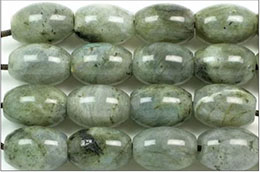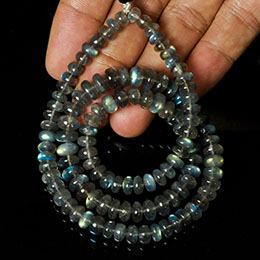Labradorite Gemstone
Labradorite Gemstone Information:

Labradorite belongs to the plagioclase feldspar poster with the same family known as “Albite”. Labradorite has been discovered with some meteorites. It was mostly found in Finland during the second war, and it is also referred as falcon's-eye. Based on Eskimo’s myth, the Northern Lights were caged within the minerals along the shore of Labrador.
It is also believed that most of the soldiers from Eskimo have the capability to have free with most of the lights. Most of the lights were still fascinated within the rock, and hence, we have this attractive stone so-called as “Labradorite”. Labradorite, displays a sparkling spectrum of colors used in ornaments as well as, with lapidary objects.
It is also a decorative gemstone and it has several popular uses such as in attractive clock faces, counter tops and tables, facing for structures, and many more. By tradition, Labradorite is considered to convey good luck. Due to its exclusive colour outcome, it can easily identify among any other minerals. in controlling metabolism as well as, with the digestive process.

Colors:
Labradorite is famous as spectrolite, which is a neutral variety, pitch-black with needle-like inclusions, and often referred as black moonstone. In fact, Spectrolite is a shady and opalescent blue once it sparkles, especially when the light hits it.
Holistic Aspects:
Samples of labradorite that posess good iridescent qualities are especially desired for jewelry. Labradorite is a member of the plagioclase series. Like all plagioclase members, its crystal system is triclinic, meaning that three directions of cleavage are present, two of which form nearly right-angle prisms. Its iridescence is the result of light refracting within perthitic lamellar intergrowths resulting from phase exsolution on cooling. Labradorite occurs as clear, white to gray, blocky to lath-shaped grains. Twinning is common in labradorite.
Labradorite ((Ca,Na)(Al,Si)4O8), is a feldspar mineral, an intermediate to calcic member of the plagioclase series. It is usually defined as having "%An" (anorthite) between 50 and 70. The specific gravity of labradorite ranges from 2.71 to 2.74. The refractive index ranges from 1.555 to 1.575.
The geological type area for labradorite is Paul's Island, near the town of Nain in Labrador, Canada. It's found in common mafic igneous rocks such as basalt and gabbro, as well as in anorthosites. It occurs in large crystal masses in anorthosite and shows an iridescence or play of colours.
Gemstone varieties of labradorite exhibiting an especially high degree of iridescence are called spectrolite. Moonstone and sunstone are also commonly used terms.

Comment (0)